K
KMS
Well-known member
TURBO TALK – CLUTCHES PART 1
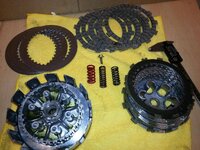
This is a weekly discussion on "grey" areas in regards to turbocharging. I answer many of the same questions everyday...one at a time on many confusing subjects that really are misunderstood. I want to help, so, we will open up 1 new topic per week to provide accurate information and explain how and why stuff works. This week‘s topic is Clutches. Big power requires a clutch ready for the challenge.
Here are some of the FAQs:
What clutch setup is the best? Who makes the best plates? What springs should I run? What oil works the best? Cork plates or Kevlar?
When I first started boosting single cylinder four strokes more than 15 years ago, there was next to nothing available to upgrade a clutch to withstand 80+ hp on a single cylinder atv. I had to learn about clutches the hard way...by burning them up and then trying something different. This painful and expensive journey was my "crash course" into the design and function of clutches (whether I wanted to learn or not).
Friction plates:
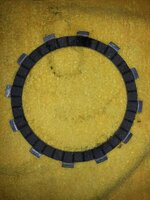
There are 3 primary styles of friction plates available:
Cork
Kevlar
Carbon Fiber
Cork is what you find in 99% of all oem clutches. It is my favorite and here is why: It is low cost and requires a low pressure to achieve a high level of friction. For example, at 300 lbs of applied pressure (clutch springs) a standard 8 friction plate system will transmit over 95% of 30 ft/lb of rotational force...what the heck does that mean? Simply put the cork plates only "lose" 5% on a bike that makes about 50hp with 300 pounds worth of spring pressure.
There are many aftermarket supplies of Cork friction plates. They use various grades and some even embed different material into the Cork to give the clutch different characteristics and feel. However, I have yet to run across a brand of Cork style that let me down. I have used brands to where the quality of the aluminum used for the base was substandard and prematurely failed, but that’s not the Cork’s fault. That is cutting corners in manufacturing. So, what do I use? Tusk. Rocky Mountain ATV. They have a great price, the base aluminum is great and I have beat them to death in very high horsepower turbo applications. The have stood up to the challenge year after year for my turbo customers.
Kevlar and Carbon fiber, here we go...The use of these comes down from drag racing. They are designed to be resistant to plate fractures during launch. There sole purpose is to add binding strength and structural integrity to the aluminum friction plate core. However, there is a huge problem with these plates...They require a very high amount of pressure to achieve a high level of friction. To achieve 95% efficiency, a 8 friction plate system the clutch will need almost 450 lbs of pressure (so much force the pressure plate deforms when you pull the clutch lever). If you have ever installed a Kevlar clutch kit that comes with springs, you probably know exactly what I am talking about....You need King Kong sized forearms to operate the clutch lever and the clutch will most likely drag, causing notchy shifting and neutral becomes impossible to find.
What people forget here is it did come down from drag racing. These bikes usually have lockout systems and can apply upwards to 1500 lbs of force to a clutch system. The clutches will go from a high rev free spin, to a locked up scenario in a fraction of a second. Remember, at the center of the friction plate is a thin aluminum core...During the launch, the Kevlar and Carbon fiber will keep the plates from exploding and serve the purpose. However, the drag racers can supply the needed force to deliver, where most clutch springs cannot.
Drive plates:
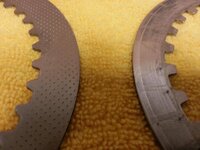
Steel or aluminum? I am a huge fan of steel drive plates, why? They have a rougher surface. Most steel plate are stamped with a rough pattern. The reason is simple, added friction. This makes it easier for the friction plate to bite into the drive plate. Steel does warp easier than aluminum, however if your clutch is getting hot enough to warp steel plates, the clutch system as a whole is the problem, not the steel plates. Aluminum plates are usually associated with Kevlar or Carbon Fiber plates because they are slippery and help with clutch drag problems created by the gorilla clutch springs. Whether you run steel or aluminum, it is always a good idea to make sure these plates have a rough finish. Scotch brite can deliver a great cross hatch pattern that gets the job done every time.
Clutch springs:
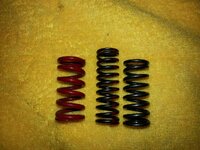
A very simple device here, however it is very mis-marketed. I cannot tell you how many times a customer has provided me a set of clutch springs to install and they end up being either way too stiff or, even worse, softer than stock...Yes. You read that right. I will not bring up names here but they are companies out there, and yes even the big ones, that sell "heavy duty" springs that are actually softer than stock. My suggestion is the take charge and do the math for yourself. For bikes that make about 50-60 hp, you want about 300 lbs total force, For bikes that make 40-50hp, you want about 275 lbs of total force. And 30-40hp about 250 lbs of total force. To get total force you need to measure the clutch spring pressure at its installed height and multiply that number by how many springs are used in the system.
For example:
Installed height spring pressure = 46 lbs
Number of springs used = 6
Total Force = 276
Ok Kelly, I do not have a fancy spring compressor, so how the heck do I get this measurement? Well, neither do I. All you need is a bench top drill press and a bathroom scale. The first measurement you need is the installed height of the spring shown here using a set of vernier calipers. NOTE: if your clutch bolts use "cup style" washers you need to add this to your measurement.
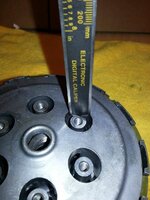
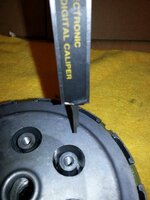
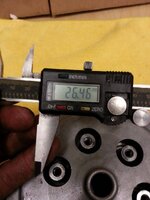
Next, place the scale under the drill press. Place a piece of flat aluminum on top of the scale so the spring does not cause the scale to collapse in the center. I turn the chuck in the drill press so the 3 collets protrude and help to center and stabilize the spring. Reusing your vernier calipers, set the drill press to stop at your installed height. Zero out the scale, install the spring and compress to the stop. The scale will do the rest.
Tip: You may find that you have one set set of springs that are way too soft and another set that are way too stiff. No problem. You can stagger these springs to get the desired total force you need:
For example:
Spring A=46 lbs, Spring B=63 lbs
(3) 46 springs + (3) 63 springs
Total force= 327 lbs
or
For example:
Spring A=46 lbs, Spring B=63 lbs
(3) 46 springs + (3) 63 springs
Total force=310 lbs
Note: If you use different spring rates, you must have them staggered across from each other. Otherwise the pressure plate will lift off center and drag. If your clutch has 5 or 3 springs, you are screwed. You cannot stagger, you must find exactly what you need from the manufacture. Barnnet has done this for me many times over.
Clutch drag:
A dragging clutch is very bad for your bike. I would rather have a clutch that is slipping than a clutch that is dragging. Drag, simply put, is when the clutch does not fully disengage the power flow to the transmission. This will cause the bike to creep when in gear with the clutch lever pulled in. What's the big deal? Clutches that drag can break your transmission. Every time you shift, you are tearing against the back cut dogs and slogs and ruining the machine work that will hold you gear in place under power. It also destroys the hardening in these areas and usually bends the crap out of shift fork. So, if your clutch drags...fix it.
Oil:
Not all oils are build equal, and neither are the additives. Your clutch (unless your snowbike is a Ducati) is submerged in oil. The primary reason for a "wet" clutch design is temperature reduction, thus longer life. There is a dark side to this story. If your oil is "too good" and does not carry friction additives, your clutch will slip and fail way more than you would like. That is where the fear of a synthetic oil comes from. The biggest difference between "motorcycle" and "automotive" oil is the friction additives (car oil does not have to deal with a clutch). The use of a synthetic oil that has wet clutch friction additives is perfectly fine. Again, some synthetics have better additives than others. Some automotive oils do have friction agents, but they are usually brands like Red line, Amsoil, and Motul. So what oil do I use? If i use a conventional oil, I use Honda or Suzuki oil. If I want the very best protection, I use Red Line Race Oil. For the weight of oil, that depends on how cold it is. (higher temps =higher wt, lower temps=lower wt.)
Please hit me with any questions you may have (even if you disagree). The purpose of this is to answer many questions about very specific things...More importantly, to avoid costly mistakes. I value your questions and they often shine a light on areas that I forgot to mention.
Next week will be part 2: Clutch upgrades like lockouts and slipper clutches.
Thanks

This is a weekly discussion on "grey" areas in regards to turbocharging. I answer many of the same questions everyday...one at a time on many confusing subjects that really are misunderstood. I want to help, so, we will open up 1 new topic per week to provide accurate information and explain how and why stuff works. This week‘s topic is Clutches. Big power requires a clutch ready for the challenge.
Here are some of the FAQs:
What clutch setup is the best? Who makes the best plates? What springs should I run? What oil works the best? Cork plates or Kevlar?
When I first started boosting single cylinder four strokes more than 15 years ago, there was next to nothing available to upgrade a clutch to withstand 80+ hp on a single cylinder atv. I had to learn about clutches the hard way...by burning them up and then trying something different. This painful and expensive journey was my "crash course" into the design and function of clutches (whether I wanted to learn or not).
Friction plates:

There are 3 primary styles of friction plates available:
Cork
Kevlar
Carbon Fiber
Cork is what you find in 99% of all oem clutches. It is my favorite and here is why: It is low cost and requires a low pressure to achieve a high level of friction. For example, at 300 lbs of applied pressure (clutch springs) a standard 8 friction plate system will transmit over 95% of 30 ft/lb of rotational force...what the heck does that mean? Simply put the cork plates only "lose" 5% on a bike that makes about 50hp with 300 pounds worth of spring pressure.
There are many aftermarket supplies of Cork friction plates. They use various grades and some even embed different material into the Cork to give the clutch different characteristics and feel. However, I have yet to run across a brand of Cork style that let me down. I have used brands to where the quality of the aluminum used for the base was substandard and prematurely failed, but that’s not the Cork’s fault. That is cutting corners in manufacturing. So, what do I use? Tusk. Rocky Mountain ATV. They have a great price, the base aluminum is great and I have beat them to death in very high horsepower turbo applications. The have stood up to the challenge year after year for my turbo customers.
Kevlar and Carbon fiber, here we go...The use of these comes down from drag racing. They are designed to be resistant to plate fractures during launch. There sole purpose is to add binding strength and structural integrity to the aluminum friction plate core. However, there is a huge problem with these plates...They require a very high amount of pressure to achieve a high level of friction. To achieve 95% efficiency, a 8 friction plate system the clutch will need almost 450 lbs of pressure (so much force the pressure plate deforms when you pull the clutch lever). If you have ever installed a Kevlar clutch kit that comes with springs, you probably know exactly what I am talking about....You need King Kong sized forearms to operate the clutch lever and the clutch will most likely drag, causing notchy shifting and neutral becomes impossible to find.
What people forget here is it did come down from drag racing. These bikes usually have lockout systems and can apply upwards to 1500 lbs of force to a clutch system. The clutches will go from a high rev free spin, to a locked up scenario in a fraction of a second. Remember, at the center of the friction plate is a thin aluminum core...During the launch, the Kevlar and Carbon fiber will keep the plates from exploding and serve the purpose. However, the drag racers can supply the needed force to deliver, where most clutch springs cannot.
Drive plates:

Steel or aluminum? I am a huge fan of steel drive plates, why? They have a rougher surface. Most steel plate are stamped with a rough pattern. The reason is simple, added friction. This makes it easier for the friction plate to bite into the drive plate. Steel does warp easier than aluminum, however if your clutch is getting hot enough to warp steel plates, the clutch system as a whole is the problem, not the steel plates. Aluminum plates are usually associated with Kevlar or Carbon Fiber plates because they are slippery and help with clutch drag problems created by the gorilla clutch springs. Whether you run steel or aluminum, it is always a good idea to make sure these plates have a rough finish. Scotch brite can deliver a great cross hatch pattern that gets the job done every time.
Clutch springs:

A very simple device here, however it is very mis-marketed. I cannot tell you how many times a customer has provided me a set of clutch springs to install and they end up being either way too stiff or, even worse, softer than stock...Yes. You read that right. I will not bring up names here but they are companies out there, and yes even the big ones, that sell "heavy duty" springs that are actually softer than stock. My suggestion is the take charge and do the math for yourself. For bikes that make about 50-60 hp, you want about 300 lbs total force, For bikes that make 40-50hp, you want about 275 lbs of total force. And 30-40hp about 250 lbs of total force. To get total force you need to measure the clutch spring pressure at its installed height and multiply that number by how many springs are used in the system.
For example:
Installed height spring pressure = 46 lbs
Number of springs used = 6
Total Force = 276
Ok Kelly, I do not have a fancy spring compressor, so how the heck do I get this measurement? Well, neither do I. All you need is a bench top drill press and a bathroom scale. The first measurement you need is the installed height of the spring shown here using a set of vernier calipers. NOTE: if your clutch bolts use "cup style" washers you need to add this to your measurement.



Next, place the scale under the drill press. Place a piece of flat aluminum on top of the scale so the spring does not cause the scale to collapse in the center. I turn the chuck in the drill press so the 3 collets protrude and help to center and stabilize the spring. Reusing your vernier calipers, set the drill press to stop at your installed height. Zero out the scale, install the spring and compress to the stop. The scale will do the rest.
Tip: You may find that you have one set set of springs that are way too soft and another set that are way too stiff. No problem. You can stagger these springs to get the desired total force you need:
For example:
Spring A=46 lbs, Spring B=63 lbs
(3) 46 springs + (3) 63 springs
Total force= 327 lbs
or
For example:
Spring A=46 lbs, Spring B=63 lbs
(3) 46 springs + (3) 63 springs
Total force=310 lbs
Note: If you use different spring rates, you must have them staggered across from each other. Otherwise the pressure plate will lift off center and drag. If your clutch has 5 or 3 springs, you are screwed. You cannot stagger, you must find exactly what you need from the manufacture. Barnnet has done this for me many times over.
Clutch drag:
A dragging clutch is very bad for your bike. I would rather have a clutch that is slipping than a clutch that is dragging. Drag, simply put, is when the clutch does not fully disengage the power flow to the transmission. This will cause the bike to creep when in gear with the clutch lever pulled in. What's the big deal? Clutches that drag can break your transmission. Every time you shift, you are tearing against the back cut dogs and slogs and ruining the machine work that will hold you gear in place under power. It also destroys the hardening in these areas and usually bends the crap out of shift fork. So, if your clutch drags...fix it.
Oil:
Not all oils are build equal, and neither are the additives. Your clutch (unless your snowbike is a Ducati) is submerged in oil. The primary reason for a "wet" clutch design is temperature reduction, thus longer life. There is a dark side to this story. If your oil is "too good" and does not carry friction additives, your clutch will slip and fail way more than you would like. That is where the fear of a synthetic oil comes from. The biggest difference between "motorcycle" and "automotive" oil is the friction additives (car oil does not have to deal with a clutch). The use of a synthetic oil that has wet clutch friction additives is perfectly fine. Again, some synthetics have better additives than others. Some automotive oils do have friction agents, but they are usually brands like Red line, Amsoil, and Motul. So what oil do I use? If i use a conventional oil, I use Honda or Suzuki oil. If I want the very best protection, I use Red Line Race Oil. For the weight of oil, that depends on how cold it is. (higher temps =higher wt, lower temps=lower wt.)
Please hit me with any questions you may have (even if you disagree). The purpose of this is to answer many questions about very specific things...More importantly, to avoid costly mistakes. I value your questions and they often shine a light on areas that I forgot to mention.
Next week will be part 2: Clutch upgrades like lockouts and slipper clutches.
Thanks


